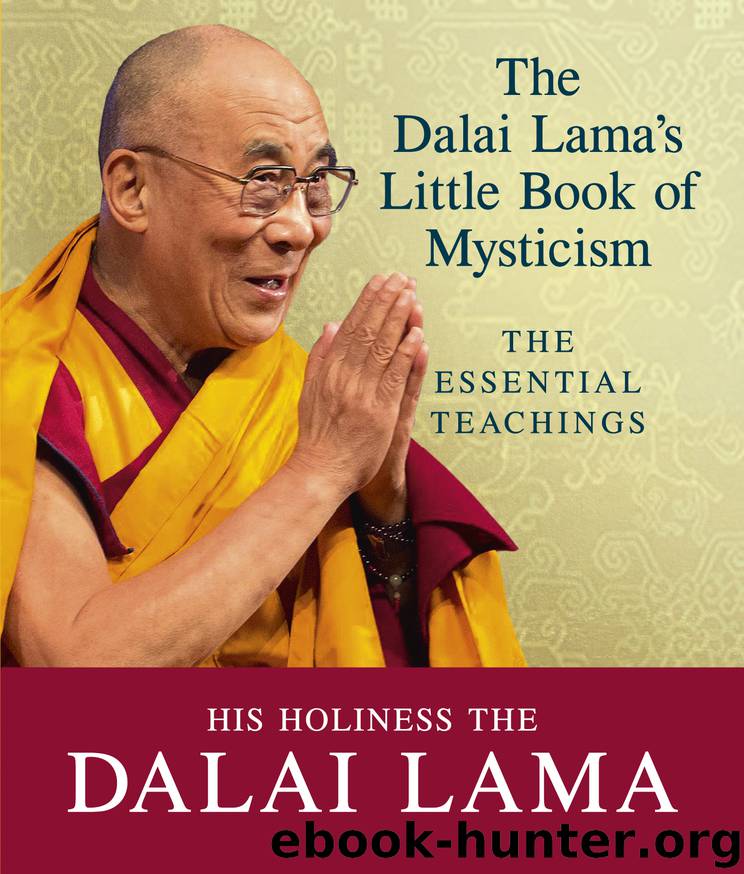The Dalai Lama's Little Book of Mysticism by Dalai Lama

Author:Dalai Lama
Language: eng
Format: epub
Publisher: Ebury Publishing
Published: 2017-09-21T04:00:00+00:00
Regarding the Three Principal Aspects of the Path, how the teaching is dealt with in this text and in the Lamrim texts is different. Here in the stages of the path texts, the Lamrim is written for the benefit of three types of beings. So, the approach is to benefit these three types of beings or three types of individuals—those with small, medium, and superior capacities. In accordance with the needs of these three types of beings, the Lamrim text has been laid out. In our text, the approach is slightly different. And in Ratnavali, which translates as The Jewel Garland, Master Nagarjuna says the teaching of the Buddha basically is to attain the means to higher rebirth, and then ultimately the means for what is known as definite goodness, or liberation, and finally enlightenment.
So, the Three Principal Aspects of the Path are mainly focusing on these points of how we should escape this samsara and reach the omniscient stage and attain the state of liberation. Of course when we talk about liberation, we should talk and base our liberation on freedom from samsara and all defilements and the trainings that lead to that. With regard to the practice of morality, what the basis of morality basically constitutes is the practice of restraint from harming others. Therefore, when we talk about morality, we must think of not harming others and keeping that percept of not harming others. That comes along within the practice of developing the path to liberation, and the main path, or the means to reach that highest liberation, is of course the practice of bodhicitta in order to reach the all-knowing state of Buddhahood. Bodhicitta is rooted in love and compassion (or loving kindness and compassion), and when we develop bodhicitta, we should first develop compassion as well. Compassion here is the main thing that we generate in developing bodhicitta. Now compassion is this attitude or this wish for others to be free from suffering, and when you wish to develop this attitude of wishing others to be free from suffering, what is really important is for you to actually understand and be aware of what suffering actually is.
If you don’t know what suffering means, then you cannot have this real, genuine wish for others to be free from suffering. Hence, we have to know the suffering that is within ourselves and we have to actually acknowledge and become aware of the condition that we ourselves are in. We are in the condition called the condition of suffering and therefore by becoming aware of our own suffering, it will be much more effective for us to develop compassion toward others. Therefore you have to develop this wish to be free from suffering for yourself first, and that is what is known as the thought of definite emergence, usually translated as renunciation. Now, when you wish to develop this renunciation for samsara, this cycle of existence, you must be aware of suffering and wish to be free of this suffering.
Download
This site does not store any files on its server. We only index and link to content provided by other sites. Please contact the content providers to delete copyright contents if any and email us, we'll remove relevant links or contents immediately.
The Way of Zen by Alan W. Watts(6292)
Ego Is the Enemy by Ryan Holiday(4963)
The Art of Happiness by The Dalai Lama(3851)
The Book of Joy by Dalai Lama(3704)
Why Buddhism is True by Robert Wright(3290)
Spark Joy by Marie Kondo(3089)
Shift into Freedom by Loch Kelly(3031)
Happiness by Matthieu Ricard(2888)
A Monk's Guide to a Clean House and Mind by Shoukei Matsumoto(2786)
The Lost Art of Good Conversation by Sakyong Mipham(2443)
The Meaning of the Library by unknow(2390)
The Third Eye by T. Lobsang Rampa(2174)
The Unfettered Mind: Writings from a Zen Master to a Master Swordsman by Takuan Soho(2160)
Red Shambhala by Andrei Znamenski(2073)
Anthology by T J(2047)
The Diamond Cutter by Geshe Michael Roach(1957)
Thoughts Without A Thinker: Psychotherapy from a Buddhist Perspective by Epstein Mark(1899)
Advice Not Given by Mark Epstein(1766)
Twilight of Idols and Anti-Christ by Friedrich Nietzsche(1764)
